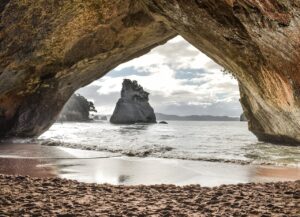Heavy rain caused chaos on the Coromandel Peninsula’s road system over Auckland Anniversary weekend.
On State Highway 25A, an entire section of road collapsed near the summit between Kōpū and Hikuai. The road had already been reduced to a single lane during daytime hours for the previous week, due to the appearance of surface cracks on the road.

Geotechnical teams had been assessing the damage, but worsening rain forced the road to close completely on Friday afternoon. A significant potion gave way over the weekend, leaving guard railings dangling in mid air above the crevasse.
Thames Coromandel District Mayor Len Salt told The Profile the road was in serious condition.
“They’re going to be struggling to rebuild the road in the same site because the substructure underneath that road down to a depth of about 25 metres is not stable,” he said.
Coromandel MP Scott Simpson agreed, saying the repair was going to be a big job for Waka Kotahi New Zealand Transport Agency.
“I think we’re looking at months rather than weeks. [It] really just highlights the need for some serious investment in our roading infrastructure to make sure that we do have access to parts of the Coromandel Peninsula when events like this happen.”
Mayor Salt and Mr Simpson both stressed the need for a more resilient road system on the peninsula.
“When the region is completely cut off there are obvious concerns about people’s health and safety,” Mr Simpson said.
“I’m always concerned about what happens if there’s a medical emergency and how people are coping; particularly those that live alone, that are elderly or have disabilities. Those people are at risk.”
However, both men were heartened to hear reports of people rallying to provide shelter and food to those in need over the weekend.
“That is the real Coromandel spirit, and it’s really heartwarming to see that happen,” Mayor Salt said.
Waka Kotahi Bay of Plenty and Waikato director of regional relationships David Speirs said he appreciated how significant SH25A was for the Coromandel and how frustrating the closure was for locals and visitors. The transport agency was working through solutions for a long-term fix, he said.
“The situation is complex due to the amount of road surface and earth lost in the collapse. As soon as the weather allows, the geotechnical assessment will recommence, which will inform the best way to re-build the road as robustly as possible.”
The ability to start physical work on site would depend on site conditions, which would be assessed this week, he said.
Meanwhile, Thames-Coromandel Civil Defence warns the Coromandel Peninsula is heading into “unknown territory” as weather forecasts show this storm was predicted to extend well into this week, raising further concerns that the catchments “may not cope”.
On Monday, MetService issued a heavy rain watch for Tuesday and Wednesday. Thames Coromandel District Council said numerous slips, debris and fallen trees were likely to continue to impact the district, with surface flooding likely, especially during the high tide cycles.
Civil Defence Controller Garry Towler said this was the region’s third extended storm this month.
“The impacts on our roading network and coast is already significant and costly, and we still have a few days to go until things ease,” he said.
“Everyone needs to take care, be aware of what’s going on and avoid taking risks.”
Nearly every section of the Coromandel’s roading system was closed at some point over the weekend, with the north end of the peninsula still isolated on Monday morning. Tapu-Coroglen Rd and the 309 Rd were closed to all but residents. Both roads had under slips and surface damage from previous storms, and were not suitable for heavy traffic.
SH25 also suffered, with multiple slips on Whangapoua Hill and at Ruamahanga Bay on the Thames Coast causing closures in several places, and there was a large slip between Whangamatā and Whiritoa. The road was closed between Coromandel Town and Whitianga on Sunday night. There was also widespread flooding across the district. SH25 south of Whangamatā was closed for a brief time on Sunday.
While SH2 through the Karangahake Gorge did remain open, the DOC carpark and Owharoa Falls were closed.
“The impact’s pretty severe,” Mayor Salt said.
“Since the beginning of January, we’ve had record rainfall – over a metre of rain. It would normally take until June until we get rain of this level.”
The Hauraki district was less affected by the weather, however, flooding and slips isolated Kaiaua and closed SH2 at Mangatawhiri and Mangatarata.
Although Ngātea residents rushed to fill sandbags as to protect their homes as water levels rose on Sunday night, Hauraki District Mayor Toby Adams told The Profile on Monday morning the flood waters had receded fairly quickly.
Residents were asked to conserve water due to the Paeroa and Waihī water treatment plants becoming clogged with silt and debris, leaving the reservoir’s water level below 30 per cent and declining steadily. A pump was being brought in from Hamilton to circumvent the blocked pipe in the hope to supply the plant.
By ALICE PARMINTER, Public Interest Journalism funded by NZ on Air





